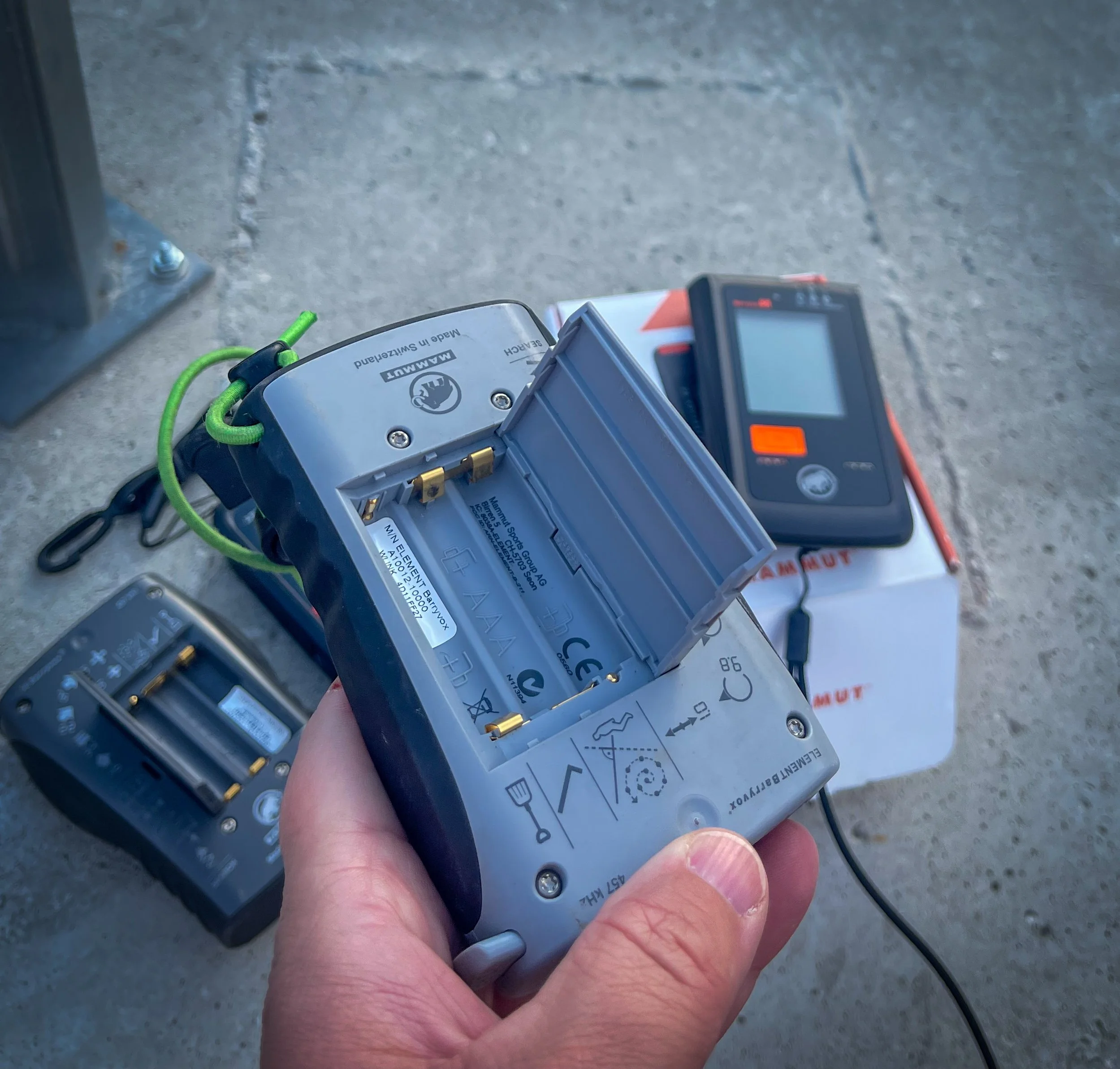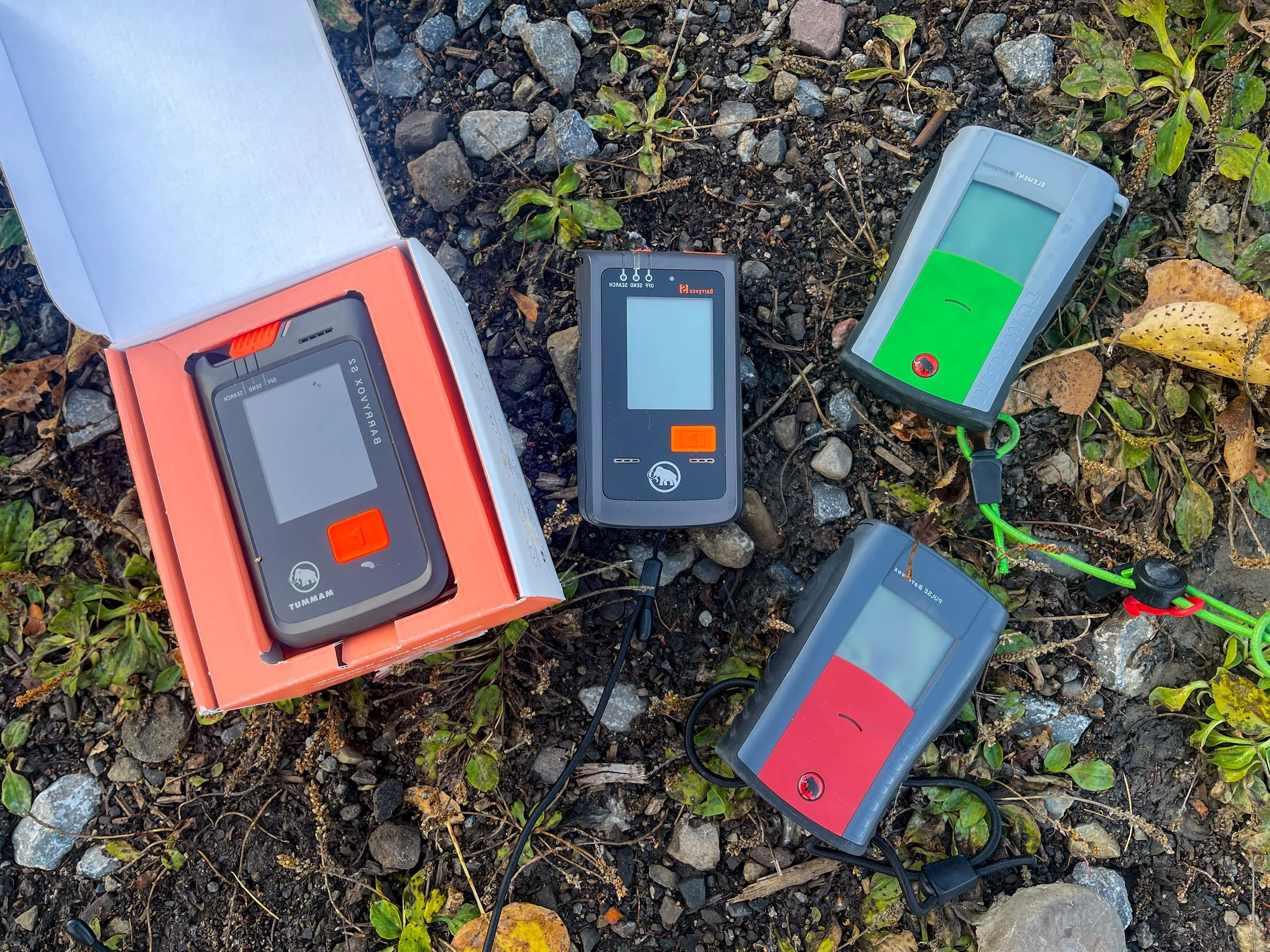PRESEASON TUNE-UP: IS YOUR AVALANCHE TRANSCEIVER MOUNTAIN-READY?
Snow is starting to stick in the alpine, and the gear bins are coming out again. It’s the time of year when everyone’s tuning sleds and checking trailers—but the most important system check isn’t under the hood. It’s the one strapped across your chest: your avalanche transceiver.
And yes, “transceiver” is the correct term. You’ll still hear people call them beacons, beepers, or locators, but in avalanche safety, the right word matters. Avalanche transceivers both transmit and receive on a universal frequency of 457 kHz, allowing your riding partners to find you, and you to find them, if a burial occurs. “Beacons” and “SOS devices” (like inReach. Zoleo, or SPOT) are completely different tools that operate on satellite networks; they’re designed for communication and coordination, not for real-time avalanche rescue.
Your avalanche transceiver is one link in your safety chain. It doesn’t prevent accidents, but when something goes wrong, it’s the tool that helps your partners find you fast. Like all electronics, it has a lifespan, and performance can degrade over time.
Photo: From the 1970s Skadi to today’s digital beacons — avalanche tech has come a long way. If yours is showing its age, it’s time to update.
AVALANCHE TRANSCEIVERS HAVE A LIFESPAN - HERE’S WHY
Even if your transceiver powers up and appears to work, internal components can degrade over time. Cold, vibration, and years of battery swaps all take their toll.
Here’s what can go wrong even when it “looks fine”:
Cracked or broken antennas can drastically reduce range and accuracy.
Frequency drift can cause your signal to move off the 457 kHz standard, making you harder to find.
Aging components and weak connections can result in poor signal strength or unstable reception.
Outdated firmware can lead to slower search processing or glitches.
Most manufacturers and avalanche educators recommend retiring transceivers no later than about seven years, even if they appear to work. Beyond that, parts and firmware support become limited, and performance can’t be guaranteed.
“THIS IS RESCUE EQUIPMENT.
WHEN THINGS GO WRONG, YOU WANT THE BEST TECHNOLOGY WORKING FOR YOU.”
If your unit has fewer than three antennas, lacks digital processing, or can’t receive firmware updates, it’s considered past its service life. Modern transceivers aren’t just newer; they’re smarter and easier to use. Faster signal processing, greater range, and clearer displays make searches quicker and more intuitive; especially for riders who don’t practice often or are new to the backcountry.
Upgrading isn’t about chasing new gear - it’s about giving your crew every possible advantage when seconds count.
WHAT’S NEW IN AVALANCHE TRANSCEIVER TECHNOLOGY
If you haven’t looked at the latest transceivers in a while, the technology has come a long way:
Three-antenna digital transceivers are now standard, giving faster, more accurate searches.
Multiple burial marking helps rescuers manage complex scenarios with multiple signals.
Improved range and stability - modern units often exceed 60 meters.
Firmware updates optimize performance and fix bugs as they’re discovered.
Bluetooth connectivity on newer models allows easy updates and diagnostics from your phone.
Technology has caught up with how snowmobilers actually move through terrain - fast, dynamic, and often spread out. Modern units are built for that.
YOUR PRESEASON AVALANCHE TRANSCEIVER CHECKLIST
Get your transceiver dialed before the first big storm. These checks fall into two easy stages: what you can do at home, and what you should test in the field with a partner.
AT HOME CHECKS
1. Read Your Operator’s Manual
Every transceiver is a little different. Take five minutes to read (or re-read) your manual each fall. It’s the best way to refresh your understanding of the device’s functions, features, and limitations.
2. Visual Inspection
Look for cracks, dents, corrosion, or stiff switches. Make sure the display is bright and buttons respond properly. If you see damage or the casing feels loose, retire the unit.
3. Battery Check
Start the season with fresh batteries. Use alkaline unless the manufacturer specifies otherwise, and never mix brands. Remove batteries when storing for long periods.
4. Firmware Update
Check your software version (it often flashes on startup) and compare it with the latest version listed on the manufacturer’s website. Updating ensures the most accurate search algorithms and power management.
5. Function Self-Test
Most modern units perform a self-check when powered on. Confirm it passes, and note any error codes. If something seems off, refer to your manual or contact the manufacturer or a certified service shop before using it.
FIELD TESTS WITH A PARTNER
1. Preseason Range Test:
Choose an open area away from buildings, vehicles, powerlines, or metal.
Place one transceiver in send mode and keep it stationary.
Walk away with your transceiver in search mode until you first pick up the signal. Compare that distance to the manufacturer’s stated range.
Rotate your transceiver in different orientations to ensure consistent detection.
Switch roles and repeat.
If your detection range is significantly shorter than expected—say under 30 meters when spec is 50–60—get the unit inspected or replaced.
2. Preseason Full Function Function Test
Confirm everyone’s transceiver transmits and receives properly.
Do a short single-burial search to check directional arrows and distance accuracy.
Test the auto-revert-to-send function (if equipped).
Take a moment to learn what models your riding partners carry and how they operate—including how to switch between send and search, power on and off, and recognize each display. Some transceivers also include advanced features like site scan, signal suppression, or marking functions that can make them better suited for specific roles during a rescue, so it’s worth knowing who in your group carries what.
FIRMWARE AND UPDATE RESOURCES
Keep your device up to date with the latest firmware directly from the manufacturers:
THE BOTTOM LINE
Avalanche transceivers are not just gear, they’re critical components of life-saving rescue equipment. When things go wrong, you want the best technology in your hands to make the search faster, easier, and more effective for everyone involved.
A quick preseason check, or an overdue upgrade, isn’t about chasing new gadgets; it’s about being ready for your crew and the terrain. Reliable tools make hard situations easier, and they give you the confidence to act when every second matters.
Next up, we’ll talk about some search practice ideas that are actually fun and will get your riding group engaged, confident, and tuned up for the season ahead…
Words and photos:
Justin Boehm is the owner of Elk Valley Snow Shepherds in Fernie, BC, where he guides, teaches avalanche courses, and delivers BCSF SledSafe training for riders who use sleds on the job. A CMBGA Level 3 Guide and Avalanche Educator, he’s worked with everyone from SAR teams and RCMP to BC Parks and industrial crews in some of BC’s most challenging terrain. Justin keeps training real, relevant, and always a little fun—because learning to ride safe shouldn’t be boring.













